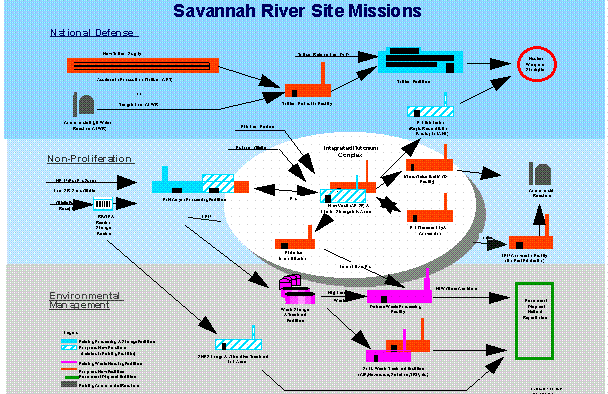
WSRC-MS-98-00571
This report was prepared as an account of work sponsored by an agency of the United States Government. Neither the United States Government nor any agency thereof, nor any of their employees, makes any warranty, express or implied, or assumes any legal liability or responsibility for the accuracy, completeness, or usefulness of any information, apparatus, product or process disclosed, or represents that its use would not infringe privately owned rights. Reference herein to any specific commercial product, process or service by trade name, trademark, manufacturer, or otherwise does not necessarily constitute or imply its endorsement, recommendation, or favoring by the United States Government or any agency thereof. The views and opinions of authors expressed herein do not necessarily state or reflect those of the United States Government or any agency thereof.
This report has been reproduced directly from the best available copy.
Available to DOE and DOE Contractors from the Office of Scientific and Technical Information, P. O. Box 62 Oak Ridge, TN 37831; prices available from (423) 576-8401.
Available to the public from the National Technical Information Service, U.S. Department of Commerce, 5285 Port Royal Road, Springfield, VA 22161.
The U.S. Department of Energy's emphasis on legacy facilities and waste remediation is widely known in the nuclear community. However, this focus has reduced the visibility of several new facilities that are currently being designed for tritium production or plutonium disposition. This paper provides an overview of several new facilities that will require robotics and remote systems to reduce radiation exposure, provide consistent product quality, and increase facility security. Key missions, general descriptions, remote equipment features, design approaches, and status of the following facilities are discussed: Accelerator Production of Tritium, Plutonium Immobilization Facility, Actinide Packaging and Storage Facility, and the Tritium Extraction Facility.
Since the end of the cold war and related weapons treaties, the U.S. Department of Energy (DOE) focus on environmental cleanup and facility decommissioning have caught the attention of the American and International Nuclear community. Recent activities in the efforts to manage the nuclear materials stockpile and the facilities needed to accomplish the DOE missions into the next century have received relatively little publicity. As these facilities start to emerge from the early conceptual stages toward authorization and construction, a key factor in their respective designs is the use of remote technologies. The driving force of worker protection is still the main justification for the use of remote equipment. However, other factors such as security, product consistency, and work cell flexibility are making in-roads in the justification of remote system usage in these latest facility designs.
This paper has been organized in to six major sections. The first section briefly describes the current and future missions being pursued by the Savannah River Site. The next four sections deal with each new major facility in its entirety, and the final major section discusses commonalties observed in the approaches and uses of remote systems across these projects.
Until the end of the cold war era, the Savannah River Site (SRS) produced nuclear materials for use in the nation's nuclear weapon stockpile. Operations included five nuclear reactors, two chemical separation areas, reactor fuel and target materials fabrication facilities, and various support facilities such as the Savannah River Technology Center and infrastructure support. Today SRS is pursuing new missions to utilize existing facility capability and technical expertise to stabilize and store legacy nuclear materials, as well as continue to support the nation's enduring weapons stockpile. The facilities described in this paper encompass the SRS pursuit of a new tritium production source through either the Accelerator or Commercial Light Water Reactor option, and the support for stabilization and disposition of Plutonium from SRS inventories and other DOE sites. Additional future missions such as the recently announced Pit Disassembly and Conversion Facility and Mixed Oxide Fuel Facility are also being planned at SRS, but are not included in this paper due to the early stages of these programs.

The Plutonium Immobilization Plant (PIP) will process various forms of plutonium (Pu) bearing materials from many different DOE facilities and convert the plutonium in to an immobilized form suitable for geologic disposal. These materials will be remotely processed in an automated glovebox environment to immobilize the plutonium in a ceramic form called a puck. These ceramic pucks will be remotely sealed inside welded cans. Remote equipment will place these cans in magazines and the magazines will be inserted into a 10 ft. (3 m) tall 24 in. (0.6 m) diameter canister that will be filled with molten, radioactive waste bearing glass from the Defense Waste Processing Facility (DWPF). This process will effectively immobilize the plutonium in a form that has been deemed equivalent to the spent fuel form in terms of attractiveness and self-protection.
The Pu immobilization plant is currently in the conceptual stages of design and process development. The DOE Office of Material Disposition is the Program Manager. Lawrence Livermore National Laboratory (LLNL) is the lead lab with the Savannah River Site being the selected plant location. LLNL and Westinghouse Savannah River Company (WSRC) teams are the key contractors involved in the program to date.
The conceptual design calls for a facility of approximately 75,000 sq. feet (6,970 sq. meters). This facility space would contain the main processing lines as described below. Administrative and support utilities are located in separate outside facilities.
Process areas are generally defined in the following various stages:
Key remote equipment features include the automated handling system for the pucks inside of the glovebox which consist of pick and place units, and a variety of robotic material handling stations. Freshly pressed pucks are somewhat fragile before sintering and must be carefully handled to prevent damage and glovebox contamination.
Transporting of the pucks and other materials throughout the process is a magnetically coupled transfer system, which is designed to minimize the number of active moving components with in containment.
Contamination free canning of the sintered pucks is accomplished through the
integration of a Cartesian robot with an automated can removal system. This
provides an automated, clean removal of the Pu pucks from the glovebox line.
Loading the cans into the tubular magazines is accomplished via hard
automation. Loading the full magazines into the empty DWPF canister will be
accomplished via a special tele-manipulator mounted on a bridge crane/rail
system in a shielded cell.
Development of the ceramic form and process parameters is in progress. Key automation equipment for the development effort has been ordered and is being received in FY99. Preliminary designs for the cans, magazines, and DWPF canister internal racks will be tested with simulated pours of molten non-radioactive glass in the spring of CY99. Current schedules and program funding call for the facility to enter Title I design in FY00 and Title II design to begin FY01.
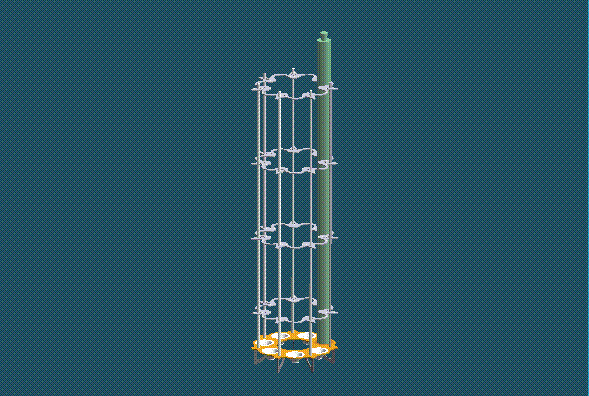
The Actinide Packaging and Storage Facility (APSF) is currently being constructed at the Savannah River Site. The purpose of the facility is the long-term storage of plutonium and plutonium bearing materials in accordance with the DOE-STD-3013-96 Criteria for long-term safe storage. The facility also falls under the US -- International Atomic Energy Agency (IAEA) Voluntary Agreement meaning it is subject to IAEA verification. Remote operations are planned for receipt operations, vault storage, retrieval and surveillance, as well as material accountability and verification operations.
The design of the APSF is being led by the Westinghouse Savannah River Company (WSRC) team with a fixed price Architectural/Engineering subcontract with Stone and Webster Engineering. Construction is being accomplished primarily by fixed price subcontracts. This is also one of the first US DOE facilities to be subject to IAEA verification and is consequently incorporating IAEA safeguards considerations into the design and demonstration phases of the program.
APSF provides a cost effective central storage facility to consolidate current Special Nuclear Material (SNM) inventory which meets DOE standards for storage of Pu metals and oxides on a time table recommended by the Defense Nuclear Facility Safety Board. The facility is designed to provide a safe and secure interim (50-year) storage facility until final material disposition options are implemented. The overall storage facility will contain approximately 47,000 sq. ft. (4,360 sq. meters). This will result in a storage capacity of 5,000 positions and a processing capacity of 2,400 containers per year. A separate area will house truck-unloading facilities. Support and auxiliary equipment areas are not included in this estimate.
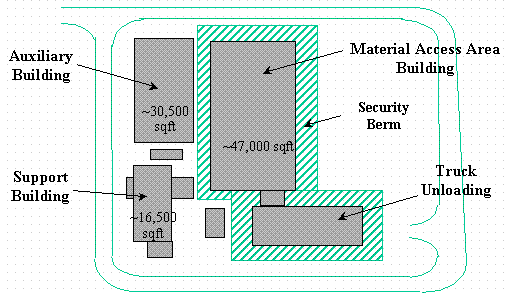
APSF also provides a thermal stabilization and repackaging glovebox line to handle out-of-specification materials or packages. This equipment is being provided by British Nuclear Fuels Limited (BNFL) as a separate system, and is similar to other systems provided to the US DOE by BNFL. The nuclear material accountability measurement area and vault materials storage areas are automated and linked to IAEA systems for verification and monitoring.
APSF uses automation to achieve exposure reduction to design basis of less than 500 mrem / employee / year, while aiding in the assurance of material accountability and international safeguards. Automated Guided Vehicles (AGVs) equipped with real time accountability and material monitoring equipment will remotely service the actual vault storage area. The AGVs will transport materials from the accountability section to the vault storage racks upon command of the facility control computer. The AGVs will be fitted with container handling devices that will place and retrieve the storage containers onto fixtures or racks mounted on the vault wall. No routine human access is planned for the vault area. Predictable equipment failures are being designed to be remotely recoverable. As an example, AGV failure recovery could be performed by another AGV specifically designed to act as a "tow truck" to remotely remove a failed AGV from the vault.
A key feature of the APSF is the Automated Accountability Measurements area. The capability to remotely monitor and verify the accountability process along with the integrity of the accountability measurements is a key design feature of this area. Remote material handling is utilized to ensure material safeguards and data integrity. An overhead gantry system is used to move material containers between accountability measurement instruments. All accountability instruments are being designed or modified to allow access from the overhead gantry. This area is also designed to operate remotely with appropriate surveillance cameras and equipment interfaces to allow IAEA monitoring of all material movements and verification of measurement integrity.
The material receipt area of the APSF includes a remotely controlled overhead bridge crane in the shipping package storage area to enable exposure limits to be met. The BNFL glovebox line incorporates automation for material handling, stabilization, and container loading operations including welding and inspection of the Interim Term Storage Container.
The APSF is currently under construction. Excavations have taken place and site preparation has been completed. Project completion is currently targeted for 2001. Another key feature of the design is the expandability of the facility by planning for the building of new processing and storage modules adjacent to the central material receipt and accountability area. This expandability will allow APSF to be flexible enough to handle future needs.
The Tritium Extraction Facility (TEF) is a new facility at the Savannah River Site that will remove Tritium from elements that are irradiated in a light water reactor. The Commercial Light Water Reactor (CLWR) option for production of tritium has been recently chosen by the Secretary of Energy as the preferred method of tritium production over the Accelerator production option.
Reactors of the Tennessee Valley Authority will be used to irradiate Tritium Producing Burnable Absorber Rods (TPBARS) to produce tritium from lithium. These irradiated TPBARS will be shipped to the new TEF facility. Due to the high radiation fields from the stainless steel clad elements, TEF will process the TPBARS in a remote facility. Processing steps will include storage, preparation, extraction, and waste package preparation.
Preliminary design for the TEF facility is complete. Key technical development items such as the large remote handling area and tritium pumping equipment are being funded for demonstration and advanced development to provide design basis information. Project construction is currently scheduled to begin FY00 with the facility ready for operation in FY06.
TEF will consist of a Remote Handling Building, a Tritium Processing Building and other support structures. The Remote Handling Building is approximately 160 ft. by 40 ft. by 60 ft. high (49m by 12m by 19m) and will contain all remote processing equipment for the TPBARS including tritium extraction furnaces. The building vertical height is necessary to accommodate lifting the long TPBARs.
The tritium process building will process the tritium gas by purifying it and readying it for use in the weapons stockpile. This building will utilize mostly existing tritium technology and is not anticipated to require any remote handling equipment.
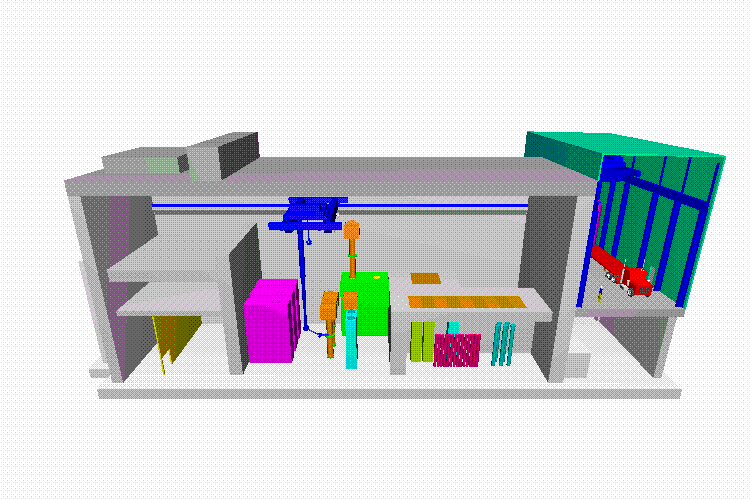
The TPBARS will be processed in the remote handling building by utilizing an overhead crane and robot system. This system will transfer the TPBARS between processing modules, which are located through out the facility at the process floor level. A unique requirement of TPBAR processing is the need for maintaining an inert atmosphere during the process steps. This will be accomplished by the use of a specially designed transporter. This device is used to transport the TPBARS in a nitrogen blanket from processing module to processing module. The transporter is manipulated by the overhead crane and utilizes double door seal technology to mate the transporter to each processing unit.
The crane and gantry system is utilized for remote equipment maintenance as well as performing routine operational tasks. The system includes various tooling to provide operational support of processing modules such as inerting operations, as well as tooling to support routine module maintenance such as installation and removal of limited life components and service jumpers.
The contractor team has completed conceptual and preliminary designs. Development and demonstration activities are now under way. At the time of writing the Secretary of Energy has just announced the decision to pursue the Commercial Light Water Reactor option as the preferred tritium production source. Programmatic funding for TEF will increase as the project moves from preliminary design towards construction. A multiyear development program is currently underway to develop and demonstrate key remote handling technologies such as the transporter and a full height robotic crane system.
The Accelerator Production of Tritium (APT) project is the backup option in a DOE dual track strategy to supply tritium to the nation's nuclear weapons stockpile. Tritium is a radioactive gas with a half-life of 12.5 years and must be periodically replaced to maintain today's modern weapons arsenal. No tritium has been produced in the United States since the late 1980s when production reactors at SRS were shut down. Due to recycle of tritium from weapons removed from the stockpile, new tritium is not needed until around 2007.
The APT project uses a linear accelerator to produce a proton beam which interacts with target/blanket (T/B) assemblies containing tungsten and a blanket gas of 3He. Through the process of nuclear spallation, neutrons are released from the tungsten and then interact with 3He gas through neutron capture to produce Tritium. 3He and Tritium gas is then extracted through a gas separation and purification system.
A team of contractors, coordinated through the National Project Office in Los Alamos, has been established to design, build, and operate the APT. Burns and Roe Enterprises, Inc. in cooperation with General Atomics, is the prime contractor. Westinghouse Savannah River Company is the Operating and Maintenance contractor. Los Alamos National Laboratory is providing expertise in accelerator design and testing. Together this team is jointly incorporating operational, technical, construction, and maintenance requirements into an integrated facility design. The specific contract with Burns and Roe requires them to turn over to the operations contractor a fully operational and tested facility.
The target/blanket (T/B) assemblies will require periodic replacement as the components in them reach the end of their irradiation life. This fact, along with needs for remote inspection and maintenance in the target/blanket building are the primary drivers for the use of remote handling equipment. Other areas of the APT project are also expected to require remote handling capability but this overview will only consider the target/blanket portion of the facility.
The T/B system is housed in a building located at the end of the approximately 0.8 mile (1.3 km) long linear accelerator. The T/B building is approximately 330 ft. long, 115 ft. wide and 100 ft. high (100 m, 35 m, by 30 m). Figure 5 shows an elevation section view of the T/B building with typical remote handling equipment required for a re-targeting operation. During operation the proton beam is expanded from a small diameter to a uniform rectangular pattern of approximately 6 inches by 63 inches (0.16 m by 1.60 m). The beam then enters the Cavity Vessel, which operates at a rough vacuum of 1 Torr.
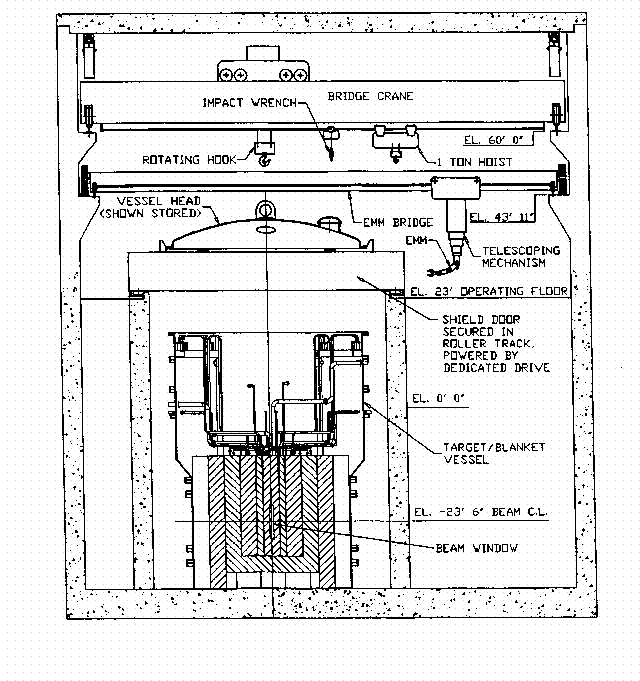
The stainless steel Cavity Vessel contains the T/B modules, neutron reflector modules, and shield modules, and is approximately 32 ft. (9.75 m) in diameter and 52 ft. (15.75 m) high. Remote equipment will be used to service and replace the modules located in the cavity vessel.
Each of the modules inside the vessel is designed to be replaceable; therefore, removable jumpers make all cooling water, helium, and instrumentation connections to the modules. Remote equipment will be required to reliably make, break, and drain these jumpers.
Remote servicing of the T/B modules will be performed by a remotely operated bridge crane and manipulator system. These components provide the flexibility and range of tooling needed to perform a variety of mechanical tasks required to change out a T/B module. A brief listing of these tasks is as follows:
Through this sequence, inspections and refurbishment are performed on limited life components such as seals and material test coupons.
The key challenges in this remote environment is the limited space for remote connections on the top of each module, the large number and variation of complex remote tasks to be performed down in the open vessel. The remote bridge cane and manipulator systems provide the needed flexibility to meet these and any foreseeable future challenges.
The contractor team has completed conceptual designs. Preliminary design, along with development and demonstration activities is now under way. At the time of writing the DOE Secretary has just announced the decision to pursue the APT as a backup to the preferred Commercial Light Water Reactor option. R&D funding for the APT option is expected to continue but out-year funding levels for remote handing development are uncertain.
Radiation protection of personnel continues to be the primary driver for remote handling and automation technologies in the DOE Facilities discussed in this paper. Lethal radiation doses associated with the TPBARs, or the cramped and congested and potentially hazardous environment of the APT Target /Blanket Cavity Vessel are traditional demands for remote systems. Demands such as the maximum limit of 500mrem/person/year radiation exposure goals require planners to consider the high personnel costs of handling materials in the Pu Immobilization facility and APSF. Safeguards needs still provide a good basis for remote or automated equipment however; production throughput and quality issues also serve as technology drivers for the PIP and APSF facilities.
Capabilities of commercial robotics and automation subsystems continue to improve and therefore form the beginning point of any equipment adaptation or remote application. The current approach to specific facility equipment development is heavily dependent upon integration of commercial products into fully functioning systems. However there remains a technology gap for operating in an unstructured or unpredictable environment, or an application requiring high reliability and fail safe recovery from anticipated equipment failures. Many vendors exist to support the high production volume needs of factories. However not many of these vendors contain the breadth of expertise needed to fully integrate one-of-a-kind equipment systems to meet the needs of these remote facilities. This integration task still remains the domain of relatively few vendors or specialty system houses.
A common feature of all four facilities discussed in this paper is that of an overhead robot and crane system. These highly flexible systems feature several advantages that have made them the choice of remote facility designs in the DOE complex since the Manhattan Project. Heavy lift capacity, the ability to be easily relocated from the process area for maintenance, as well as open and unencumbered floor space are but a few of the primary reasons these flexible systems have been included in future facility planning. At SRS, remote or teleoperated cranes have been used in the canyons and each of the five retired reactors since the 1950s. With today's modern computer controls and operator feed back systems, these reliable tools are the planned workhorses of these modern DOE facilities.
Use of small individual robots is primarily limited to the automated glovebox processing line of the PIP facility. As currently envisioned, APSF will be the primary user of AGV technology although limited use of AGVs is being considered for portions of the PIP and APT service tunnel. Flexible manufacturing concepts have found limited application in these facilities as they are primarily designed and funded as single or limited mission facilities.
Finally, the importance of full-scale mockups for process development, demonstration and testing, along with future operator training cannot be overemphasized. The large investments in heavily shielded, Class I structures of remote handling facilities must be backed up by proven process equipment designs that are remotely serviceable and maintainable via the robotics and tele-operators. Mockups provide the necessary physical check to verify designs and recommend alternate solutions. After the facility commissioning, mock-ups are well suited to train operators and maintenance personnel, ensure replacement equipment fit-up and functionality, as well as enable understanding of facility equipment capabilities to outside reviewers and regulators. Too often the values of mockups in the early planning stages are underestimated and much justification is needed to provide adequate mockups to ensure the facility success.
Not all of the DOE's effort in remote systems is focused on the challenge of clean up and restoration of cold war era facilities. Future DOE facilities are in the current planning and construction stages that will utilize remote equipment and tooling to enhance worker safety, reduce personnel exposure, as well as increase throughput and product quality. These facilities are being designed and implemented to provide long term service in an environment that will remove the workers from hazards while safely and securely ensuring our nation's defense and environmental stewardship.
Funding for the work described in this paper was provided by the U.S. Department of Energy under contract No. DE-AC09-96SR18500.
The authors would like to acknowledge the dedication of the many people of the Savannah River Site, and the various program and project offices and their contractors. Careful planning, consideration of design alternatives, and cost effective implementation of facility designs have led to an exciting future of new DOE facilities to handle the cold war material legacy and provide for the nation's defense needs.